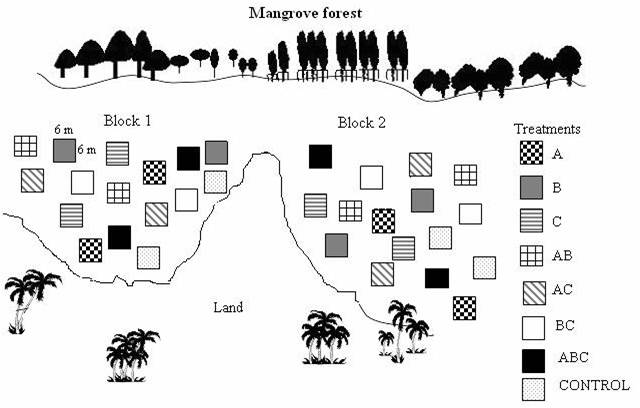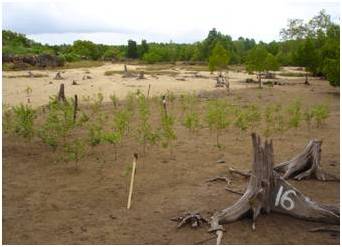The mangrove diversity and restoration experiment at Gazi Bay was established in July 2004. Three mangrove species were planted at an open, degraded site that had been mangrove forest ca. 35 years before. Its key goals were to study (1) the potential for mangrove restoration and (2) the effects of species richness on ecosystem recovery.
Design
The experiment is set up following a randomised block design with 8 treatments and 4 replicates of each treatment.

|
|
Schematic illustration of the experimental layout (not to scale)
|
Site characteristics
| location |
Kinondo |
| former land use |
natural mangrove forest that had been cut down |
| altitude |
0 m |
| soil type |
marine sediment/sand |
| area |
0.12 ha |
| no of plots |
32 |
| plot size |
6 m x 6 m |
| no of trees planted |
3 388 |
| planting date |
July 2004 |
| diversity variables |
species richness |
| diversity gradient |
1, 2, 3 sp. |
| size species pool |
3 |
| species pool |
Avicennia marina, Bruguiera gymnorrhiza, Ceriops tagal |
| contact person |
Mark Huxham |
Research
Studies focus on the effects of tree species richness on tree survival and growth, sediment moisture, and fauna.
Extra information
Send an e-mail to the contact person, visit the website of the East African Forum for Payment for Ecosystem Services, or explore the publications:
- Messier C, Bauhus J, Sousa-Silva R, Auge H, Baeten L, Barsoum N, Bruelheide H, Caldwell B, Cavender-Bares J, Dhiedt E, Eisenhauer N, Ganade G, Gravel D, Guillemot J, Hall JS, Hector A, Hérault B, Jactel H, Koricheva J, Kreft H, Mereu S, Muys B, Nock CA, Paquette A, Parker JD, Perring MP, Ponette Q, Potvin C, Reich PB, Scherer-Lorenzen M, Schnabel F, Verheyen K, Weih M, Wollni M, Zemp DC (2021) For the sake of resilience and multifunctionality, let's diversify planted forests! Conservation Letters e12829 - https://doi.org/10.1111/conl.12829
- Grossman JJ, Vanhellemont M, Barsoum N, Bauhus J, Bruelheide H, Castagneyrol B, Cavender-Bares J, Eisenhauer N, Ferlian O, Gravel D, Hector A, Jactel H, Kreft H, Mereu S, Messier C, Muys B, Nock C, Paquette A, Parker J, Perring MP, Ponette Q, Reich PB, Schuldt A, Staab M, Weih M, Zemp DC, Scherer-Lorenzen M, Verheyen K (2018) Synthesis and future research directions linking tree diversity to growth, survival, and damage in a global network of tree diversity experiments. Environmental and Experimental Botany - doi: 10.1016/j.envexpbot.2017.12.015
- Sigi Lang'at JK, Kirui BKY, Skov MW, Kairo JG, Mencuccini M, Huxham M (2013) Species mixing boosts root yield in mangrove trees. Oecologia 172: 271-278 - 10.1007/s00442-012-2490-x
- Kirui BYK, Kairo JG, Skov MW, Mencuccini M, Huxham M (2012) Effects of species richness, identity and environmental variables on growth in planted mangroves. Marine Ecology Progress Series 465: 1-10 - doi: 10.3354/meps09999
- Kirui BYK, Huxham M, Kairo J, Skov M (2008) Influence of species richness and environmental context on early survival of replanted mangroves at Gazi bay, Kenya. Hydrobiologia 603: 171-181 - doi: 10.1007/s10750-007-9270-3

|
|
The Gazi Bay Experiment
|


